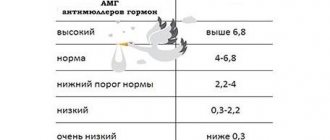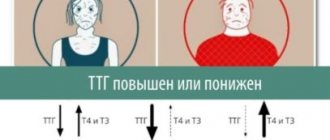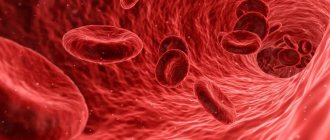What may affect the results
For women, determination of the level of luteinizing hormone in the blood, subject to regular menstruation, is usually prescribed on the 2-4th day of the cycle, unless other recommendations are indicated by the attending physician.
When donating blood, you must indicate the day of your cycle. To determine the ovularity (day of ovulation) of the cycle with irregular menstruation, the level of luteinizing hormone is determined every day from the 8th to the 18th day of the expected cycle. The concentration of luteinizing hormone in the blood can be significantly affected by severe stress, intense sports training on the eve of blood donation, and the use of oral contraceptives and hormonal medications.
Preparing for a blood test for LH hormone
The LH norm can be distorted if the simple rules of preparation for analysis are neglected. The results of a blood test for FSH and LH cannot be considered reliable if the day before you did serious physical activity, smoking immediately before donating blood, or serious overeating.
Therefore, simple preparation for analysis of pituitary hormones for FSH and LH must fulfill several conditions:
• Avoid sports training and heavy exercise 3 days before the analysis;
• It is advisable to stop smoking for at least one hour before blood is taken for analysis;
• 3a 15-20 minutes before donating blood, it is advisable to calm down and relax;
• It is better to conduct research on the 6-7th day of the menstrual cycle;
• Blood should be donated on an empty stomach, in the morning. 8-10 hours before the test you should not eat food - you can only drink water;
• Before testing for LH hormone, women are advised to indicate the date of their last menstrual period or gestational age.
If the study is performed to determine the ovulation cycle, if it is irregular, blood is taken for analysis every day between 8 and 18 days before the expected start of menstruation.
Reference values
The table shows normal values of luteinizing hormone depending on gender, age and phase of the menstrual cycle (for women).
| Age (period) | Luteinizing hormone level, mIU/ml | ||
| Women | Men | ||
| 0 - 1 year | < 3,29 | < 6,34 | |
| 15 years | < 0,27 | < 0,92 | |
| 5 – 10 years | < 0,46 | < 1,03 | |
| 10 – 14 years | < 15,26 | < 5,36 | |
| 14 – 20 years | < 15,97 | 0,78 – 4,93 | |
| over 20 years old | — | 1,14 – 8,75 | |
| Reproductive period | Follicular phase | 1,68 – 15,0 | — |
| Ovulatory phase | 21,9 – 56,6 | — | |
| Luteal phase | 0,61 – 16,30 | — | |
| Postmenopause | 14,2 -52,3 | — | |
LH and FSH ratio
This indicator allows you to get an impression of the hormonal balance in the body. The normal LH and FSH ratio in women within a year after the onset of the first menstruation is 1 – 1.5. Before the onset of menarche in girls, this ratio is 1. Between LH and FSH, the ratio in women two years after the start of menstruation until menopause occurs remains within 1.5 -2.
When one of the hormones, FSH and LH, is increased or decreased, their normal ratio changes.
Luteinizing hormone
Luteinizing hormone is a substance produced in the pituitary gland (a small endocrine gland located at the base of the skull and connected by a short stalk to a special part of the brain - the hypothalamus).
In the embryonic (intrauterine) period and after birth until puberty, the formation of luteinizing hormone in both the female and male body is constant and even - its concentration remains at a low level. An increase in the level of this hormone in women begins with the onset of fertile age.
Formed in the cells of the pituitary gland, luteinizing hormone enters the blood and reaches the gonads, where its target cells are located.
Luteinizing hormone is an important participant in the formation of eggs in the ovaries of women and sperm in the testes of men.
In addition, luteinizing hormone regulates the formation of sex hormones.
Once women reach fertile age, eggs begin to form in the ovaries, going through several stages of maturation - this process is cyclical (repeated approximately every 28 days) and is called the menstrual cycle. Inside the ovary, the egg is located in a follicle surrounded by special (somatic) cells. During each cycle, the egg acquires the properties necessary for fertilization and the formation of a viable embryo. By the middle of the menstrual cycle, luteinizing hormone is released, which ensures ovulation - the timely release of a mature egg. By the time of ovulation, the concentration of luteinizing hormone increases sharply. Luteinizing hormone triggers and regulates the final stages of egg maturation and the rupture of the follicle for the release of a full-fledged egg into the fallopian tube, where fertilization is possible.
After ovulation, the level of luteinizing hormone decreases relative to the “ovulatory peak”, and the luteal phase of the menstrual cycle begins. During this phase, under the influence of luteinizing hormone, the ruptured follicle turns into the so-called corpus luteum, where the hormone progesterone is secreted.
In men, luteinizing hormone receptors are located on Leydig cells, which synthesize the male sex hormone testosterone.
A decrease or cessation of the formation of luteinizing hormone (pituitary insufficiency) can lead to the development of infertility, absence of menstruation, impotence, and decreased libido.
The secretion of luteinizing hormone increases with physical activity and training, and decreases with psychological stress.
Effects of LH
Normal LH in women:
• Stimulates the growth and maturation of the follicle in the ovary;
• Promotes the emergence and development of the corpus luteum;
• Thus, LH in women regulates the formation and entry into the blood of estrogens and progesterone.
LH hormone in men stimulates the work of Leydig cells, which are located in the testicles. These cells are responsible for the formation of testosterone, the most important hormone for the normal development of the male body and sexual function.
Due to the pulsed release of FSH and LH into the blood by pituitary cells, the hormone can fluctuate at different times of the day and at different hours, while remaining within normal limits in healthy people.
Reasons for increased levels of luteinizing hormone in the blood
- Basophilic pituitary adenoma.
- Hypergonadotropic hypogonadism (in women): ovarian wasting syndrome.
- Polycystic ovary syndrome.
- Endometriosis.
- Shershevsky-Turner syndrome.
- Testicular feminization.
- Prolonged fasting.
- Intense sports training.
- Kidney failure.
Functions of FSH in the female body
In women, follicle-stimulating hormone stimulates the maturation of ovarian follicles, prepares them for the effects of luteinizing hormone and enhances the release of estrogens. The entire first phase of a woman’s normal menstrual cycle - the follicular phase, which lasts 13-15 days, is devoted to the process of follicle ripening. At the beginning of this phase, each of the woman’s ovaries has several small follicles, up to 5 millimeters in size. In the process of maturation, one should stand out among them, which grows much larger than the others and becomes dominant. It is he who, upon bursting, will release the egg, which can subsequently turn into an embryo after fertilization. During the follicular phase of the menstrual cycle, the concentration of follicle-stimulating hormone gradually increases, reaching a peak when the follicle ruptures and the egg is released. If fertilization does not occur, FSH levels begin to decline until the next cycle.
Causes of decreased luteinizing hormone in the blood
- Secondary amenorrhea.
- Hyperprolactinemia.
- Pituitary dwarfism.
- Sheehan's syndrome.
- Simmonds' disease.
- Denny-Morphan syndrome.
- Polycystic ovary syndrome: atypical form.
- Luteal phase deficiency.
- Obesity.
- Smoking.
- Surgical interventions.
- Stress.
Sources:
- .
- .
- Verin V.K., Ivanov V.V. Hormones and their effects: a reference book. St. Petersburg: FOLIANT Publishing House LLC, 2012, 23-27.
- Human physiology with the basics of pathophysiology: in 2 volumes. T.1/ ed. R.F. Schmidt, F. Lang, M. Heckmann; translation from it. edited by M.A. Kamenskoy et al. – 2nd ed., M: – Laboratory of Knowledge, 2021. – 537 p.
Thyroid-stimulating hormone (TSH, thyrotropin)
A glycoprotein hormone that stimulates the formation and secretion of thyroid hormones.
It is produced by basophils of the anterior pituitary gland under the control of thyroid-stimulating hypothalamic releasing factor, as well as somatostatin, biogenic amines and thyroid hormones. Increases vascularization of the thyroid gland. Increases the supply of iodine from blood plasma to thyroid cells, stimulates the synthesis of thyroglobulin and the release of T3 and T4 from it, and also directly stimulates the synthesis of these hormones. Enhances lipolysis.
There is an inverse logarithmic relationship between the concentrations of free T4 and TSH in the blood.
TSH is characterized by daily fluctuations in secretion: blood TSH reaches its highest values at 2 - 4 am, the highest level in the blood is also determined at 6 - 8 am, the minimum TSH values occur at 17 - 18 pm. The normal rhythm of secretion is disrupted when awake at night. During pregnancy, the concentration of the hormone increases. With age, the concentration of TSH increases slightly, and the amount of hormone emissions at night decreases.
Limits of determination:
0.0025 mU/l-100 mU/l.
general information
A woman's ovarian cycle and fertility are controlled by LH and FSH, and their secretion is controlled by sex hormones. Luteotropin stimulates ovarian activity to secrete estrogen. Its peak concentration stimulates the ovulatory process, as well as the process of luteinization, when the follicle becomes the corpus luteum (temporary endocrine gland). The corpus luteum produces progesterone, a hormone necessary for the successful attachment of the embryo to the endometriotic layer of the uterus. Therefore, if pregnancy does not occur, it is important to make sure that the progesterone test is normal. If implantation has occurred, then LH contributes to the normal functioning of the corpus luteum. LH stimulates the theca cells of the ovaries, which produce androgens (male gonadosteroids) from which estradiol is formed - the most active hormone from the estrogen group (read more about the hormone estradiol and how to properly take the test for women - note altravita-ivf.ru).
Under the influence of FSH, follicles form and mature, ovulation occurs with a peak release of follitropin, and libido decreases or increases. Gonadotropic hormones affect regulation, physical development, puberty, the appearance of secondary sexual characteristics, the ability to become pregnant, bear and give birth to a child.
Deviation of FSH concentration from the norm in women - possible causes
Elevated FSH levels may indicate the following problems:
- Menopause;
- Primary ovarian failure (premature ovarian failure syndrome, ovarian tumors and cysts, Shereshevsky-Turner syndrome, 17-alpha-hydroxylase deficiency);
- Hypogonadism due to exposure to external factors on the ovaries (X-rays, chemotherapy, alcohol, infectious diseases, autoimmune diseases, trauma);
- Hyperfunction or tumors of the pituitary gland;
- Endometriosis;
- Ectopic secretion in some hormone-secreting neoplasms (usually in lung tumors);
- Premature puberty.
A decrease in FSH concentration may be a consequence of pathologies such as:
- Deficiency of hypothalamic gonadoliberin;
- Pituitary insufficiency;
- Dwarfism;
- Sheehan syndrome;
- Hyperprolactinemia;
- Neoplasms of the ovaries, testicles and adrenal glands with increased secretion of estrogens and androgens;
- Polycystic ovary syndrome;
- Hemochromatosis;
- Anorexia and starvation.









